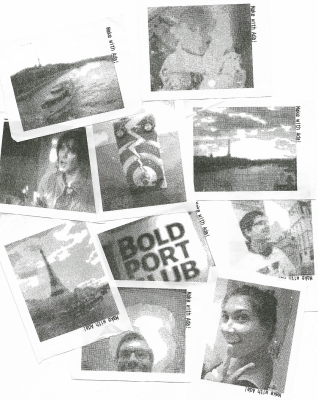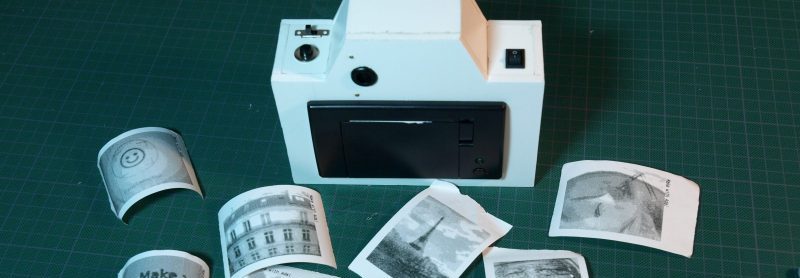Digital cameras are great, because you can take thousands of pictures without running out of film. But there’s something to be said for having a tangible image you can hold in your hand. The Polaroid cameras of yesteryear were great for this, but now they’re hard to find and the price per photograph is ludicrously expensive.

Over the past few years, a few people have sought a way to create printed photographs at a lower cost. One of the best ways to do this is to find something much cheaper than Polaroid film — like thermal paper.
[Fabien-Chouteau]’s thermal printing camera isn’t the first — you’ve got the Gameboy Camera/Printer and a few others to thank for that. But it’s a great example of the form. The camera combines an Adafruit thermal receipt printer with an OpenMV camera, both easily sourced, if not exactly cheap. It even adds a ST7735 LCD for live display of the camera’s image, just like consumer-grade cameras!
It’s not just a slapped together kludge of parts bin components, however. While the thermal printer is only capable of printing black or white pixels, its resolution is much higher than the image from the camera. This allows the camera to use a 3×3 block of printed pixels to represent a single pixel from the camera, and with some fancy dithering techniques, can emulate shades of grey quite effectively. It’s tricks like this that really add polish to a project, and make a big difference to the picture quality at the end of the day.
It’s not the first thermal printer camera we’ve seen – [Ch00f]’s woodgrain instant camera build highlighted the issues of careful camera selection when pursuing this type of build.
Video after the break.

















What is with the clickbait style title “This Year’s Hottest Dithering Technique”? What fancy dithering technique? Fabien-Chouteau clearly states that it is a quick and dirty implementation and that something like Floyd–Steinberg would be better.
Very cool idea and clean build though. This would be great for kids or parties where you can let people go nuts with taking photos. The rolls of thermal paper are cheap so you wouldn’t mind too much.
The OpenMV board is quite expensive however. It might be better to just deal with the slow initial startup of a RPi Zero instead. RPi compatible LCD + RPi Zero + RPi camera would be about the price of the OpenMV board itself and you’d have much more processing power + the ability to save the photos as well. Getting it to auto stitch panoramas and then print out a long strip could be fun.
It´s usual here. Click-bait titles,exaggerations, approximations, copy-pasted errors, that´s HaD. And in reaction, much people complaining.
Take care with thermal paper. Much of it is full of phtalates !
Phtalates are good on pancakes.
I’m afraid that one was a phthalate and a dollar short. :(
Fantastic comment!
Stop being so quick to judge. They are just having fun making a pun, not referring to dithering algorithms. “hottest” as in, a thermal printer uses heat to mark the paper.
The dithering technique is a not-paricularly-interesting and gamma-unaware (oops!!) implementation of ordered dithering (see §2.3)
> The OpenMV board is quite expensive
There’s a lot of work that goes into OpenMV (firmware, software, support etc..) we’re not just saying here’s a micro, sensor, lcd and have at it. In addition we can’t compete with RPi manf. level (we can’t make a 10K run for example, to make it cheaper). However, that all being said, we were still able to reduce costs as much as possible so the new OpenMV revision (based on Cortex-M7) is actually going to be cheaper than the M4 (we’re currently taking pre-orders for $55). I’m not sure if that’s still expensive, but it’s definitely much cheaper than competition.
I think its a good price and I’m glad to see some projects with it. Looking fwd to more
It’s a pun! We figured it was more fun than just “DIY Instant Camera”.
> The only people using ada are ada devs
The Polaroid camera survives because it is considered an honest witness is certain circumstances in that the image cannot be manipulated.
It’s also used as a test frame in model shooting, where super-high resolution is needed (mandating slow 120 film) and models are expensive; so you don’t want to fsck it up. So; you shoot test frames on Polaroid to check your lighting and exposure, before switching to film for the real images.
Also, in Europe; Jessops sells refurbished Polaroid cameras for like €130, and Instax cameras are half that. Instax film is about €1 a photo, Impossible is about €3; and (cool hack and interesting but limited artistic effect aside) have a rather higher dynamic range, resolution; and are true optical photographs, not prints.
Interesting. Yes I can see that being a good use. My experience was with warranty investigations on aerospace parts where Polaroids were the only photographic record some OEMs would accept.
I haven’t seen film used at a pro shoot for years. $35,000 medium format digital Hasselblad and Phase One is what I see commonly, not one polaroid. Back in the 70’s and 80’s it was common, but today It’s 100% digital. 100-200MP images kick the crud out of medium format 120film it even beats out of Velva 50 in clarity which is massively slower and higher resolution than 120 speed film.
I see a few using film in 120 and 4×5 and negative scanners – B&W outdoor portraits. I have a couple hundred rolls (a thousands maybe?) of 120 and use a pair of old RB-67’s and an old Jobo rotary processor. I scxan negatives. I don’t know anyone who prints on photo paper anymore. Though if I had a scheme for a digital printer, I could use the 1500 feet or so of Kodak and Agfa paper I have to make archival prints. Any ideas out there?
Well, Fuji these days I think.
Um… because you can’t take a Polaroid of a photoshopped image?
There was a protocol for taking these photos of which there were several taken each time, and of course, the OEM had the right to demand the component be shipped back (and sometimes did) if the photographs weren’t to their liking. Generally though, the sorts of failure, which were mostly of the excessive wear type, were not unknown to the OEM, who had likely seen similar before. If the pictures didn’t show anything new, they would authorize repair/refurbishment and send a check. Mostly however this was about the sort of ass-covering that everyone does in this industry in case there is some accident that calls down a full investigation where any record that could potentially be modified after the event would be suspect.
The blue noise halftone algorithm in Digital Halftoning by Ulichney will work fine on 8 bit processors. I did it in Forth and C for the Apple IIe (with an ImageWorks II display/video frame grabber card and a laser printer) in 1988 and it worked great. Here is the book https://www.amazon.com/exec/obidos/ASIN/0262210096/acmorg-20
Try the guts from a Dymo Turbo 400 thermal label printer. That can do greyscale.
The print mechanism used can do grayscale as well. It’s just the basic firmware in the printer that does not support it. It would be easier to write new firmware for the printer than to control the raw printhead from the Dymo 400-series.
I wonder if you could use a media that has very narrow and closely spaced cyan, magenta and yellow line and use thermal transfer printing to do color prints.
Well there’s Fuji Thermo-Autochrome multicolor thermal paper, It uses multi-layer coatings with three separate colors. Color addressing is achieved by controlling the heat pulse length and intensity.
I’d be thinking of this kind of deally…
https://en.wikipedia.org/wiki/Thermal_transfer_printing